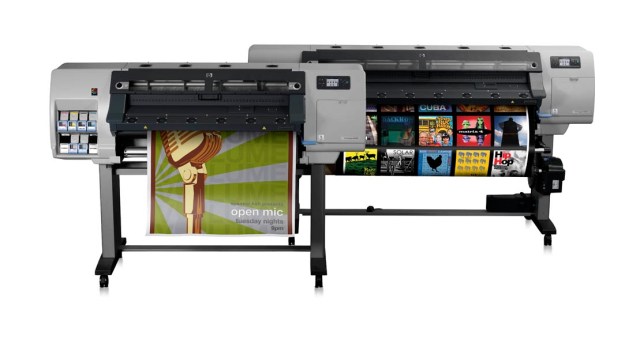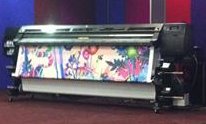When latex technology was first announced, the main argument for it was a reduced environmental impact. HP’s Designjet L25500 follows on from the group’s first latex print machine, the L65500, which was unveiled last year.
With the new machine, the green credentials, although important, don’t get star billing, but share the limelight with two other attributes in what HP terms the “triangle”.
“Firstly, latex offers application versatility; one device for all applications,” says HP large-format printing vice-president Santi Morera. “Secondly, it offers ease of operation, and thirdly, end-to-end environmental benefits.”
HP claims that latex ink is unique in the range of applications that can be handled by one technology, encompassing frontlit and backlit displays, vehicle graphics, banners and wall coverings onto a wide range of uncoated substrates.
“Customers want to expand their product ranges, either from indoor to outdoor or from outdoor to indoor,” adds Morera. “Being able to do that on one device is very important.”
HP has got eco-solvent machines in its sights – a market that is currently dominated by the likes of Mimaki, Mutoh and Roland DG, with Epson, Océ and HP just playing on the fringes. Although HP has discontinued its Designjet 8000, 9000 and 10000 series eco-solvent machines, it has latex technology in use in this L25500 model.
“Signage is a market that HP can make a significant contribution to by bringing in new technology like the HP latex inks. We have listened to what customers want and believe we have created a solution that combines the Designjet quality with the needs of the signage market,” says Shane Lucas, director, HP Graphic Arts South Pacific.
A range of different customers have been identified as suitable for the L25500: those with an aqueous ink machine such as HP’s Designjet 5000 or Z6100, those with ecosolvent machines producing vinyl and signage, and firms that have so far shunned large-format due to the limitations of solvent. “With the HP Designjet L25500 printer we are providing the market with a truly competitive alternative to solvent,” says Lucas.
Latex refers to “a non-allergenic synthetic polymer developed especially for inkjet printing,” according to HP’s senior technical specialist, printing technology platforms Ross Allen. The ink is primarily water, along with polymers, pigments and additives to help everything work together. In the printing zone, a heater is used to evaporate off the water, resulting in a viscous ink and polymer particle film.
Allen cites a viscous ink as advantageous. “It means dot gain and colour-to-colour bleed are minimised,” he says, which therefore simplifies colour management and profiling.
The action of the heat and some of the additives bond the ink to the substrate. From there, the image passes into the next heating unit, where the temperature is raised further to melt the polymer and forming v tough ink film. The resulting print is durable: the life expectancy of unlaminated outdoor print is three years, according to HP.
Energy considerations
Beta testers say that the inclusion of “a dirty great heater” on the L25500 undermines some of the environmental claims for the device, due to its additional energy consumption.
However, HP counters that the heater, which requires an additional 15-amp socket to power it, uses less energy than the combined heater and air purification unit required for solvent machines. One wrinkle in its argument is that some eco-solvent machines don’t require purification and some solvent jobs are run without the heater. However, HP is preparing an environmental impact report that compares the L25500 with a raft of eco-solvent machines to back up its environmental claims.
Allen explains that HP would like to do away with PVC as a substrate. “We’re working hard to develop many PVC-free applications,” he says. “But any new printing technology needs to accommodate vinyl, especially for vehicle and outdoor applications. We realised we needed something that would eliminate eco-solvent, but it has to perform like eco-solvent or people will say it doesn’t give the industry what it needs.”
HP has a range of 19 substrates for the L25500, six of which are new and seven of which are eligible for the firm’s free ‘take-back and recycle’ scheme. Under the scheme, HP will arrange the take-back of any eligible HP-supplied media. HP launched the scheme after customers using these potentially recyclable media said other recycling firms weren’t inter- ested in the small volumes of materials they were producing.
In addition to its own media, the L25500 is compatible with a wide range of media from leading third-party vendors and HP has set up a media certification centre in Spain to work with these firms to ensure compatibility.
Unlike most UV inks, the latex ink used in the L25500 is inherently flexible and conformable – essential for vehicle wrapping.
HP claims that latex outperforms eco-solvent by making vinyl prints easier to install. Solvents tend to soften the vinyl, which means it can stretch and distort while the fitter is trying to position the graphic. Latex doesn’t, so the vinyl retains its original form.
With a maximum speed of 22.8m2 per hour and a recommended monthly production volume of 500m2, it may not be as fast as some eco-solvent machines, but there is more to productivity than throughput alone. Print from the L25500 is totally dry and ready for finishing out of the printer, unlike solvent output, which requires several hours of ‘out gassing’ before it can be laminated.
Competing for cost
Consumables costs, including ink, printheads and cleaning station, are claimed to be comparable to eco-solvent, with the added advantage of the environmental benefits and the wider range of applications.
There is no option of an embedded controller/RIP, but there are eight third-party RIPs that can drive the L25500: AIT Shiraz, Cadlink, Caldera, ColorGate, Ergosoft, Onyx, SAi and Wasatch.
An embedded web server allows remote access to the machine to check status and troubleshoot, including information about ink and media consumption, which can be used to feedback into your MIS if your RIP doesn’t include those functions itself.
Having hinted at an entry-level machine before the launch of the L25500, HP has also confirmed that latex technology will be continued up the range.
“Thermal inkjet and latex gives us a lot of potential,” says Morera. “It will be used in more productive machines and for printing rigids. Latex will fill a very broad range of applications, but it will co-exist, there is still space for UV-cured and solvent technology.”
Comment below to have your say on this story.
If you have a news story or tip-off, get in touch at editorial@sprinter.com.au.
Sign up to the Sprinter newsletter


